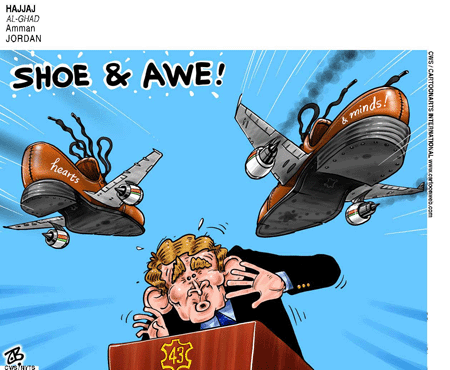Wednesday, January 07, 2009
NYT: Car Bomb Near Baghdad Shrine Kills 24, as Iraqi Shiites’ Holiest Month Approaches

Iman Kadim, one of those wounded Saturday in a Baghdad car bombing that the authorities said killed at least 24, was hospitalized. Many victims were pilgrims visiting a nearby Shiite shrine.
Car Bomb Near Baghdad Shrine Kills 24, as Iraqi Shiites' Holiest Month Approaches
BAGHDAD — A car bomb killed at least 24 people, many of them Shiite pilgrims, and wounded 46 others when it exploded Saturday on a busy road in Baghdad that leads to the revered shrine of Kadhimiya, according to the Ministry of Interior.
That bombing, along with several others in recent weeks, was a stark reminder that even as violence has sharply fallen, insurgents still have the power to carry out deadly strikes in the heart of the capital. The attack's timing and location appeared to be intended to reignite sectarian passions.
Millions of Shiites are preparing to commemorate the martyrdom of Imam Hussein, grandson of the Prophet Muhammad. The observance falls during Muharram, the holiest month of the Shiite religious calendar, which begins Monday. Shiite families from across Iraq traditionally visit the shrine, with its shimmering twin golden domes, on Saturdays.
The explosion occurred at midday about 100 yards from Bab al-Dirwaza, one of the main gates to the shrine and the Kadhimiya district's bustling market, which has been a pedestrian-only area for several years because of a spate of deadly attacks in the area. According to several witnesses, the car that exploded was parked outside the fence of one of the nearby parking lots.
Jalal Hussein, 56, had just parked his car, after dropping off his wife and daughter at the gate, when the bomb exploded a few yards away, creating a huge ball of fire that consumed several vehicles and many pedestrians. He said the bodies and limbs of victims, including many children and women, were scattered everywhere.
"It was an unexpected massacre of simple people going to visit the shrine," said Mr. Hussein, who was wounded in the shoulder.
On the street in front of the lot, which was cordoned off by American and Iraqi forces, the chassis of a car lay amid the wreckage of a minibus and five other vehicles in one lane. A woman's shoe and shreds of the black head-to-toe cloak commonly worn by Iraqi women mixed with blood, broken glass and metal. A smashed bus was in the other lane.
"My son," screamed a distraught mother who had rushed there with her husband.
Rescuers tried to force open the doors of vehicles to remove the dead and wounded, witnesses said. Many badly burned bodies were simply piled up on wooden market pushcarts.
Muhammad Hamdan, 58, who narrowly escaped the blast, had come to the shrine with his wife and six children to pray to be cured of a heart ailment. "Those who perished are martyrs, God willing," he said.
Residents and visitors expressed shock and anger that the bombing occurred in what is considered one of the city's most secure enclaves. The neighborhood is ringed with Iraqi Army and police checkpoints, where each entering vehicle is scanned with a hand-held bomb detection device.
The area receives special attention because it is home to the shrine and the base of Ayatollah Hussein Ismail al-Sadr, a Shiite cleric close to Prime Minister Nuri Kamal al-Maliki.
The tight security led several residents to lash out at what they assumed to be incompetence or corruption that had allowed the bombing to happen. "This area is highly protected," Mr. Hussein said. "Not even a rat could come in. The terror is from within."
A Kadhimiya resident, Fawzia Qazzaz, standing on her porch overlooking the scene, screamed at security personnel as tears rolled down her cheeks. "Either their bomb detection equipment is faulty or they are implicated in the terror," she said.
In another bombing on Saturday, in Jurf al-Sakher, south of Baghdad in Babil Province, an Iraqi Army officer and two members of a local Awakening Council were killed when a bomb attached to their vehicle exploded, according to a police official in Hilla, the provincial capital.
While the sectarian bloodshed that had ripped Iraq apart as recently as last year has eased, devastating attacks continue to crop up. The last major attack in the capital, a suicide bombing at a police training academy on Dec. 1 , killed at least 15 people.
A new report released Saturday by the nongovernmental group Iraq Body Count placed at 8,955 the number of civilians killed by acts of violence in Iraq so far in 2008. The figures, while far below those of 2006 and 2007, when a total of 51,894 civilians were killed, were only slightly below those for 2003 and 2004, according to the report.
Meanwhile, the police in Ramadi, west of Baghdad, killed an escaped prisoner who was believed to be an insurgent leader. The prisoner, Emad Ahmed Ferhan, was among three who escaped Friday from a police station after a shootout that killed six policemen and seven prisoners.
The police received a tip on Saturday that he was hiding at a house in central Ramadi and sent a force to arrest him, said the police chief, Maj. Gen. Tareq al-Youssef. He said the force had surrounded the house and a gun battle had ensued with Mr. Ferhan, who was described as a leader of Al Qaeda in Mesopotamia, a homegrown Sunni extremist group that American intelligence agencies say is led by foreigners.
He was killed as he fled. A machine gun, passport and fake beard were in his possession, General Youssef said.
Abeer Mohammed contributed reporting from Baghdad, and Iraqi employees of The New York Times from Ramadi and Hilla.